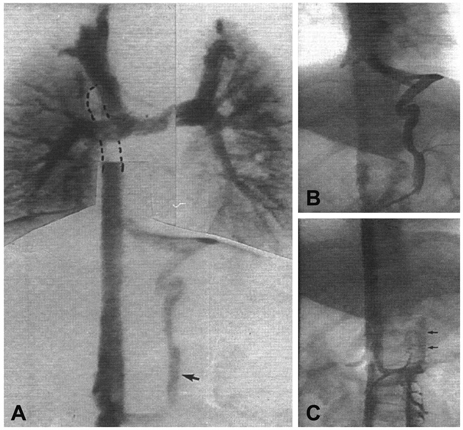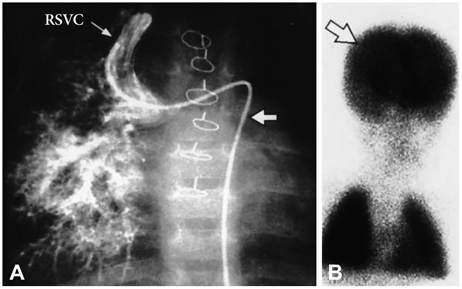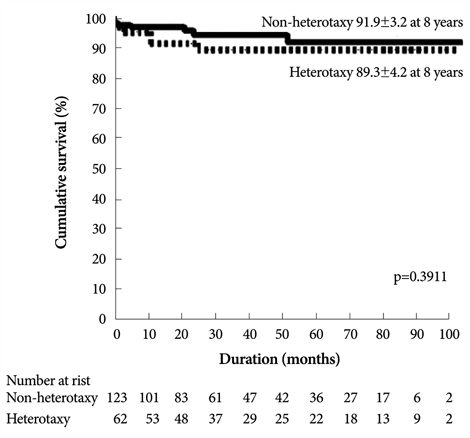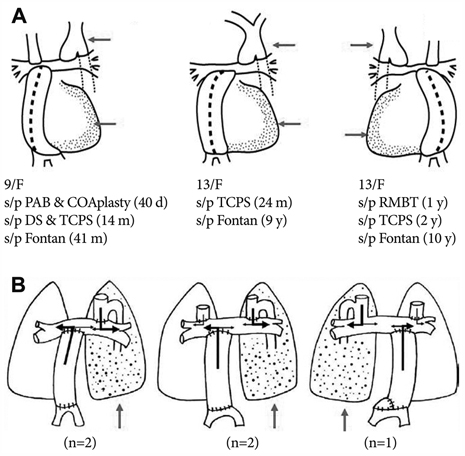Korean Circ J.
2011 May;41(5):227-232. 10.4070/kcj.2011.41.5.227.
Heterotaxy Syndrome
- Affiliations
-
- 1Division of Pediatric Cardiology, Department of Pediatrics, Konkuk University Hospital, Seoul, Korea. ksoojn@yahoo.co.kr
- KMID: 2297927
- DOI: http://doi.org/10.4070/kcj.2011.41.5.227
Abstract
- Heterotaxy is defined as an abnormality where the internal thoraco-abdominal organs demonstrate abnormal arrangement across the left-right axis of the body. This broad term includes patients with a wide variety of very complex cardiac lesions. Patients with heterotaxy can be stratified into the subsets of asplenia syndrome and polysplenia syndrome, or the subsets of heterotaxy with isomerism of the right atrial appendages and heterotaxy with isomerism of the left atrial appendages. Treatment of patients with isomerism is determined by the nature and severity of the associated cardiac and extracardiac lesions. Most cardiac operations for patients with isomerism are palliative in nature, since normal anatomy is rarely achieved and mortality rates remain high for patients with heterotaxy syndrome. Patients with left isomerism in general have less severe cardiac malformations than those with right isomerism and, hence, more chance of biventricular repair. For almost all patients with right isomerism, and for many with left isomerism, biventricular repair will not be feasible, and all palliative protocols are then staging procedures prior to a Fontan-type repair. Recent advances in medical management, and improvements in surgical techniques have resulted in improved survival for these patients, and the surgical outcomes are comparable to those with Fontan circulation irrespective of the presence or absence of heterotaxy.
Keyword
Figure
Reference
-
1. Jacobs JP, Anderson RH, Weinberg PM, et al. The nomenclature, definition and classification of cardiac structures in the setting of heterotaxy. Cardiol Young. 2007. 17:Suppl 2. 1–28.2. Andeson RH, Baker EJ, Penny DJ, Redington AN, Rigby ML, Wernovsky G. Paediatric Cardiology. 2010. 3rd ed. Philadelphia: Churchill Livingstone/Elsevier.3. Kim SJ, Kim WH, Lim HG, Lee JY. Outcome of 200 patients after an extracardiac Fontan procedure. J Thorac Cardiovasc Surg. 2008. 136:108–116.4. Bartz PJ, Driscoll DJ, Dearani JA, et al. Early and late results of the modified fontan operation for heterotaxy syndrome 30 years of experience in 142 patients. J Am Coll Cardiol. 2006. 48:2301–2305.5. De Tommasi S, Daliento L, Ho SY, Macartney FJ, Anderson RH. Analysis of atrioventricular junction, ventricular mass, and ventriculoarterial junction in 43 specimens with atrial isomerism. Br Heart J. 1981. 45:236–247.6. Freedom RM. The asplenia syndrome: a review of significant extracardiac structural abnormalities in 29 necropsied patients. J Pediatr. 1972. 81:1130–1133.7. Ticho BS, Goldstein AM, Van Praagh R. Extracardiac anomalies in the heterotaxy syndromes with focus on anomalies of midline-associated structures. Am J Cardiol. 2000. 85:729–734.8. Dyke MP, Martin RP, Berry PJ. Septicaemia and adrenal haemorrhage in congenital asplenia. Arch Dis Child. 1991. 66:636–637.9. Murdoch IA, Anjos RD, Mitchell A. Fatal pneumococcal septicaemia associated with asplenia and isomerism of the right atrial appendages. Br Heart J. 1991. 65:102–103.10. Waldman JD, Rosenthal A, Smith AL, Shurin S, Nadas AS. Sepsis and congenital asplenia. J Pediatr. 1977. 90:555–559.11. Blieden LC, Moller JH. Analysis of the P wave in congenital cardiac malformations associated with splenic anomalies. Am Heart J. 1973. 85:439–444.12. Wren C, Macartney FJ, Deanfield JE. Cardiac rhythm in atrial isomerism. Am J Cardiol. 1987. 59:1156–1158.13. Momma K, Takao A, Shibata T. Characteristics and natural history of abnormal atrial rhythms in left isomerism. Am J Cardiol. 1990. 65:231–236.14. Ho SY, Seo JW, Brown NA, Cook AC, Fagg NL, Anderson RH. Morphology of the sinus node in human and mouse hearts with isomerism of the atrial appendages. Br Heart J. 1995. 74:437–442.15. Dickinson DF, Wilkinson JL, Anderson KR, Smith A, Ho SY, Anderson RH. The cardiac conduction system in situs ambiguus. Circulation. 1979. 59:879–885.16. Frogoudaki A, Sutton R, Gatzoulis MA. Pacing for adult patients with left atrial isomerism: efficacy and technical considerations. Europace. 2003. 5:189–193.17. Humes RA, Feldt RH, Porter CJ, Julsrud PR, Puga FJ, Danielson GK. The modified Fontan operation for asplenia and polysplenia syndromes. J Thorac Cardiovasc Surg. 1988. 96:212–218.18. Culbertson CB, George BL, Day RW, Laks H, Williams RG. Factors influencing survival of patients with heterotaxy syndrome undergoing the Fontan procedure. J Am Coll Cardiol. 1992. 20:678–684.19. Uemura H, Yagihara T, Kawahira Y, Yoshikawa Y. Anatomic biventricular repair by intraatrial and intraventricular re-routing in patients with left isomerism. Cardiol Young. 2001. 11:12–16.20. Kawashima Y, Matsuda H, Naito Y, Yagihara T, Kadoba K, Matsuki O. Biventricular repair of cardiac isomerism with common atrioventricular canal with the aid of an endocardial cushion prosthesis. J Thorac Cardiovasc Surg. 1993. 106:248–253. discussion 253-4.21. Koh M, Yagihara T, Uemura H, et al. Biventricular repair for right atrial isomerism. Ann Thorac Surg. 2006. 81:1808–1816. discussion 1816.22. Lim HG, Bacha EA, Marx GR, et al. Biventricular repair in patients with heterotaxy syndrome. J Thorac Cardiovasc Surg. 2009. 137:371–379.23. Allen HD, Driscoll DJ, Shaddy RE, Feltes TF. Moss and Adams' Heart Disease in Infants, Children, and Adolescents. 2008. 7th ed. Philadelphia: Lippincott William & Wikins.24. Kawashima Y, Kitamura S, Matsuda H, Shimazaki Y, Nakano S, Hirose H. Total cavopulmonary shunt operation in complex cardiac anomalies: a new operation. J Thorac Cardiovasc Surg. 1984. 87:74–81.25. Stümper O, Wright JG, Sadiq M, De Giovanni JV. Late systemic desaturation after total cavopulmonary shunt operations. Br Heart J. 1995. 74:282–286.26. Kim SJ, Bae EJ, Cho DJ, et al. Development of pulmonary arteriovenous fistulas after bidirectional cavopulmonary shunt. Ann Thorac Surg. 2000. 70:1918–1922.27. Srivastava D, Preminger T, Lock JE, et al. Hepatic venous blood and the development of pulmonary arteriovenous malformations in congenital heart disease. Circulation. 1995. 92:1217–1222.28. Kim SJ, Bae EJ, Lee JY, Lim HG, Lee C, Lee CH. Inclusion of hepatic venous drainage in patients with pulmonary arteriovenous fistulas. Ann Thorac Surg. 2009. 87:548–553.29. McElhinney DB, Kreutzer J, Lang P, Mayer JE Jr, del Nido PJ, Lock JE. Incorporation of the hepatic veins into the cavopulmonary circulation in patients with heterotaxy and pulmonary arteriovenous malformations after a Kawashima procedure. Ann Thorac Surg. 2005. 80:1597–1603.30. Yun TJ, Al-Radi OO, Adatia I, et al. Contemporary management of right atrial isomerism: effect of evolving therapeutic strategies. J Thorac Cardiovasc Surg. 2006. 131:1108–1113.31. Kim SJ, Kim WH, Lim HG, Lee CH, Lee JY. Improving results of the Fontan procedure in patients with heterotaxy syndrome. Ann Thorac Surg. 2006. 82:1245–1251.






